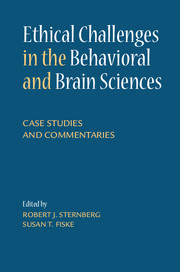Book contents
- Frontmatter
- Contents
- List of Contributors
- Preface
- Part I Academic Cheating
- Part II Academic Excuses and Fairness
- Part III Authorship and Credit
- Part IV Confidentiality’s Limits
- Part V Data Analysis, Reporting, and Sharing
- Part VI Designing Research
- Part VII Fabricating Data
- Part VIII Human Subjects
- 44 Ethical Considerations When Conducting Research on Children’s Eyewitness Abilities
- 45 Studying Harm-Doing without Doing Harm
- 46 Observational Research, Prediction, and Ethics
- 47 Should We Tell the Parents?
- 48 Ethics in Human Subject Research in Brazil
- 49 Honesty in Scientific Study
- 50 Ethically Questionable Research
- 51 Commentary to Part VIII
- Part IX Personnel Decisions
- Part X Reviewing and Editing
- Part XI Science for Hire and Conflict of Interest
- Epilogue Why Is Ethical Behavior Challenging?
- Index
- References
47 - Should We Tell the Parents?
Balancing Science and Children’s Needs in a Longitudinal Study
Published online by Cambridge University Press: 05 February 2015
- Frontmatter
- Contents
- List of Contributors
- Preface
- Part I Academic Cheating
- Part II Academic Excuses and Fairness
- Part III Authorship and Credit
- Part IV Confidentiality’s Limits
- Part V Data Analysis, Reporting, and Sharing
- Part VI Designing Research
- Part VII Fabricating Data
- Part VIII Human Subjects
- 44 Ethical Considerations When Conducting Research on Children’s Eyewitness Abilities
- 45 Studying Harm-Doing without Doing Harm
- 46 Observational Research, Prediction, and Ethics
- 47 Should We Tell the Parents?
- 48 Ethics in Human Subject Research in Brazil
- 49 Honesty in Scientific Study
- 50 Ethically Questionable Research
- 51 Commentary to Part VIII
- Part IX Personnel Decisions
- Part X Reviewing and Editing
- Part XI Science for Hire and Conflict of Interest
- Epilogue Why Is Ethical Behavior Challenging?
- Index
- References
Summary
The research described in this chapter was supported by the National Institute of Child Health and Human Development (NICHD) through a cooperative agreement (U10), which calls for scientific collaboration between the grantees and the NICHD staff. Hirsh-Pasek and Weinraub were both participating scientists in this project.
In the late 1980s and early 1990s, the United States was engaged in a massive natural experiment. More than 52% of women with children under age 6 had entered the workforce, and a new term, “dual career families,” was born. In this context, families wrestled with the question of whether they should send their young children to childcare and just how much alternative care was good or bad for their babies.
At the time, the scientii c community offered parents a mixed bag of advice. Some studies stressed the importance of maternal care and found that placing children in childcare was a risk (Belsky, 1999 , 2001 ; White, 1985 ). Others reported the opposite effects, demonstrating cognitive and social boosts from playing with other children in childcare (Clarke-Stewart, Gruber & Fitzgerald, 1994 ; Lamb, 1998 ). Still others suggested that placing a child in childcare had little or no effect on child outcomes (e.g., Scarr, 1998 ). Moving from the science to more personal accusations, there were assertions that the positive results from childcare studies emerged only when women were the experimenters, and counterclaims also emerged that i ndings against using childcare were promulgated by researchers searching to maintain an Ozzy and Harriet caricature of the mom at home. No broad spectrum and dei nitive research on the topic had been conducted – until now.
- Type
- Chapter
- Information
- Ethical Challenges in the Behavioral and Brain SciencesCase Studies and Commentaries, pp. 145 - 148Publisher: Cambridge University PressPrint publication year: 2015

